Sysop hosted a couple of back-to-back seminars in London and Manchester on 5th and 6th December 2018. Across the two events 34 people represented 26 separate organizations from varying market sectors. The topic for the day was High Velocity Service Management, a relatively new term that has arisen to reflect how IT Organisations are adjusting the way that they provision their services to meet increasing demand from the business.
We kicked off the events by getting the delegates to discuss amongst themselves:
“What would you consider High Velocity Service Management to be?”
The responses back from the individuals and the groups discussions were captured and form the basis for the “High Velocity Service Management” the following Wordcloud:
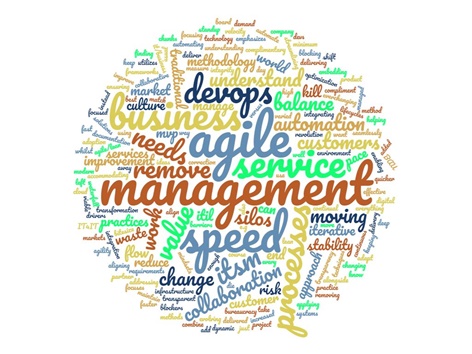
There was consensus that High Velocity Service Management included adapting to an agile approach to service management. The high velocity element referring to how quickly IT can respond to changing needs of the business. Management approaches such as DevOps, Agile, Lean, IT4IT and ITIL were all mentioned as key contributors to a high velocity approach. Other interesting related terms such as collaboration, automation, flow, culture, mindsets, iterative were also mentioned. Breaking down silos, balancing risk against stability and less process focus kept cropping up in the feedback as well.
This exercise served as a useful introduction for the day and helped to set the scene. It was clear that there already was an overall awareness in the room about the changing world for service management. It was therefore interesting to find out the progress that had been made in aligning IT services to adapt to these ways of working.
We therefore asked the group:
“What progress has been made within your organization in introducing a High velocity approach to service management?”
The responses are summarized as follows:
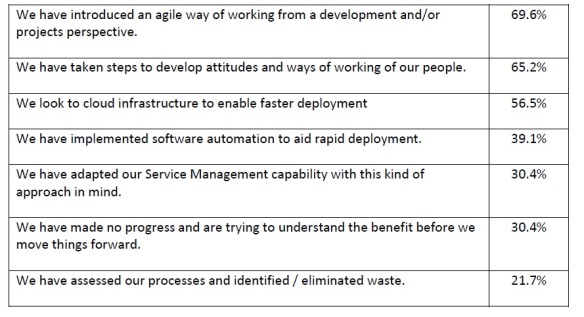
These responses were interesting with nearly a 1/3 indicated that they had made no progress and are trying to understand the benefit before moving things forward. This also goes hand-in-hand with the same low percentage of responders who are yet to adapt their service management capability in line with this approach. This indicates that for many, they are still at the early stages of identifying how to leverage new ways of working.
The largest response with over 69% indicated that an agile approach is being deployed from a development and/or projects perspective. We often find that without agile thinking in service management then silo working is inevitable with new developments “thrown over the fence” for Operations to support and from discussions with some of the delegates this behaviour was evident at the coal face.
It was clear from all respondents that the vast majority had invested in cloud technology for the provision of some of their key services but only just over half were using the technology as an aid for faster deployment. This, alongside a low score for automation being used indicates the full potential of technology solutions are still to be realised.
Around two thirds of the respondents demonstrated an awareness of the need to change mindsets and attitudes of people having indicated they have made progress in this area and this will be a key part of introducing new approaches.
The Changing ITSM Landscape
The first presentation session for the day took a step back and looked at why the change in landscape for service management. Specifically, what is driving the need for change, looking at the modern business world and digital transformation leading to high velocity service delivery. Approaches such as Agile Service Management, DevOps, SIAM and VeriSM™ have emerged and/or increased in relevance as strategic approaches to keep up with change.
We explored how technology was having a dramatic effect on how businesses do their business. Increasing dependencies on technology establishes the IT service provider as more of a business partner, converging IT and the business to work together as one. Digital Transformation has emerged with the realization that technology can drive business growth and help to increase market share. This increasing demand from the business has led to the need for faster response in delivering projects and implementing changes, with any delays impacting speed to market and reducing competitive advantage.
IT service management has traditionally had the perceived concern of controlling change and protecting the environment, managing risk as the highest priority. Whilst this approach is still necessary, innovation is becoming an increasing priority and finding the balance is the key to how to structure the service management capability.
Whilst ITIL® has been globally recognised as the go-to service management framework, other approaches have emerged which have perhaps been better equipped to manage the balance of innovation against risk. This is one of the main reasons for ITIL to be updated which we will cover later in this white paper. The following approaches were specifically covered:
- Agile as an approach introduces an iterative way of delivering value whether that be through development, projects or the management of services.
- Lean has introduced an approach that maximises value by eliminating waste part of which is driven through automation.
- DevOps has introduced a collaborative approach, embracing Agile, Lean and service management principles.
- Cloud technology has provided flexibility in terms of options for provisioning services and cost models.
- Increased dependency on cloud service providers has accelerated the need for the role of a service integrator and SIAM (Service and Integration Management) an approach that is growing in relevance.
- VeriSM™ is Service Management for the Digital Age and its strength is the recognition that an integration of management approaches is inevitable for success.
There can be no doubt that service management has a challenge to identify how best to move forward. The following points provide a summary of the session:
- High velocity Service Delivery is no longer an option but a necessity
- Difficulty of adapting varies depending on existing practices and approaches
- There are many developing/emerging approaches to help
- Bi-modal IT introduces complexity & challenges but is the key to success
MarsLander™ – Agile Service Management simulation workshop
 The next part of the event was for the delegates to experience the MarsLander™ simulation workshop. Based on a journey to Mars, this simulation practically demonstrates service management adapting to the changing landscape and it will help organizations start their transformation journey. It will help them to explore what Agile, Lean and DevOps are all about. How to use typical Agile and Lean principles and apply them for their own service teams. It will open the mindset of managers and employees and will help them better understand how this simulation can help develop new ways of working, collaborating and aligning with new frameworks, at the same time learn about continual learning and improvement in iterative steps.
The next part of the event was for the delegates to experience the MarsLander™ simulation workshop. Based on a journey to Mars, this simulation practically demonstrates service management adapting to the changing landscape and it will help organizations start their transformation journey. It will help them to explore what Agile, Lean and DevOps are all about. How to use typical Agile and Lean principles and apply them for their own service teams. It will open the mindset of managers and employees and will help them better understand how this simulation can help develop new ways of working, collaborating and aligning with new frameworks, at the same time learn about continual learning and improvement in iterative steps.
Why a Simulation?
Business simulations such as ‘MarsLander’ are experiential learning instruments based upon learning-by-doing. A scientific study shows the effects of this type of learning and how this increases the retention of knowledge and skills gained through training, helping to maximise the Return on Value (ROV) from a training investment.
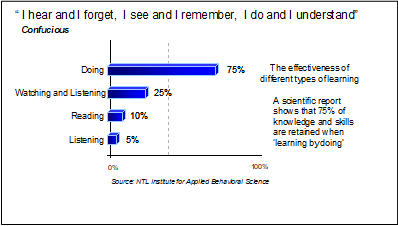
The Rounds
The full simulation consists of 4 rounds but only rounds 1 and 2 were run on these events to give a flavour of what can be achieved.
Round 1 – Launch preparation
In preparing for the launch of the rocket, the team explored the backlog of issues, features and projects and planned when to execute all the work. They considered the service requirements and made the first service design.
Specific aspects that were introduced in this round were:
- Visualization, KanBan
- Product backlog
- Service Levels
- Service and improvement backlog
- Team work
At the end of the 1st round, we asked for feedback on the delegates feelings from the round. This can be summarized as follows:
- There was an emphasis on individual tasks and not on the overall mission
- There was Silo working throughout without effective cross-team communication
- Confusion was presented as it was a challenge to understand what was going on as there was no visualization
- Bottlenecks arouse where individuals were too busy, slowing down progress
- There was uncertainty of roles and tasks where people were not sure who was doing what
- There was a lack of information being shared
- Overall it was summarized as chaotic
Round 2 – Launch and encounter Hardy IV
In round 2 the rocket was to be launched and commencing the flight to the comet Hardy IV. The Purpose of this part of the mission is to collect data from the tail of Hardy IV as part of mission goals. The team had to deal with some new issues and new requests from Mission Control.
Specific aspects in this round were:
- Product Owner, and their role
- Flow of work
- Customer centric
- Priority/Value creation
- Processes and service design
- Shared focus and goals
- ITSM constraints:
- Disconnection between operations and development
- Silo thinking and working
- Lack of team work
- Lack of flexibility
Photographs taken from the events. An innovative floor Kanban board, Fixes and changes being implemented and the more traditional visualization.
Following completion of this round, the group were asked to reflect back on the journey that had made. How had they improved between the two rounds and what learning can be taken from this that they can take back into their organizations and do something with. This is a summary of these outcomes:
- Establishing Ownership.
- Better hand-offs leading to better flow.
- How to prioritize and who should influence this.
- Clarity of mission objectives was vital for success
- Value creation through business outcomes.
- Teamwork led to better results removing silos.
- Shared goals provided a focus.
- The value of “Stop & review”.
- Empowering individuals to make decisions.
- Although still chaotic, there was more organization.
- Stand-ups helped planning.
- A valuable exercise is to establish where work comes from
- If there is spare capacity, then identify and utilize it.
- Step back and look at interactions.
- Movement & culture shift
- Sharing Pain can lead to better outcomes.
- Look at what has actually been achieved from an organization perspective.
- Improve end-to-end communication
- Visualization through Kanban is effective
- Better prioritization is needed.
- Stand-ups helped establish where to improve
- Sticking to roles drives compensation behaviour
- Redefining the model of team for agility should be considered.
- Multi-functional teams are more effective.
In the space of a few hours, these outcomes were achieved and added significant value to the learning experience of the participants. The full-day MarsLander workshop goes onto explore agile concepts further focusing on the following:
- Service Teams
- Multifunctional teams, team work
- Agility
- Service Improvement backlog
- Theory of Constraints, Bottlenecks
- Metrics
- Quality at the source
- Planned and unplanned work
- How to work with vendors in multifunctional teams?
- How to transfer from traditional ITIL® into a more Agile way of working
- How to prioritize the improvement backlog?
- How do the traditional ITIL® processes operate in an Agile way of working?
- How did we apply various best practices to deliver value?
- What are the new competences we need to develop in our own organization?
- How did we change our way of working? What was the approach?
- How did we supported Mission Control to create value?
- Did we become more effective and efficient as a team?
- How did feedback help us to become a better team?
The MarsLander™ Agile Service Management workshop will be updated to bring it in line with ITIL®4 in February 2019.
ITIL® 4 Update
ITIL itself is going through a transitional period in recognition that the world is changing. The 4th Industrial Revolution is upon us which is marked by emerging technology breakthroughs in a number of fields, including robotics, artificial intelligence, nanotechnology, quantum computing, biotechnology, The Internet of Things (IoT), 3D printing and autonomous vehicles.
The world’s most widely accepted Service Management framework has had to adapt accordingly to maintain relevance. A key element to this is how service management theory can be put into practice to enable businesses to drive digital transformation. The “4” in ITIL 4 is to actually in reference to the 4th Industrial Revolution, acknowledging the impact it has had and will have on service management.
How ITIL adapts to enable and support high velocity service management is one of the key reasons behind the update, acknowledging and integrating with other approaches such as Agile, Lean and DevOps. A summary of what ITIL 4 will bring is as follows:
- Practical & flexible to support Digital Transformation
- Help align human, digital & physical resources
- Emphasis on business & technology world and how it will work with Agile, DevOps and Digital Transformation
- More relevant to developers, practitioners and businesses
- Emphasis on the importance of collaboration, transparency, automation and working holistically
- Moves from traditional process lead delivery to faster quality and value driven delivery for people & organizations
The first development is the release of the ITIL 4 Foundation course which will be available from February 2019. The next release will see the advanced modules released to provide either a practitioner or strategic approach depending on the course and qualification. Here is the ITIL 4 Certification Scheme:
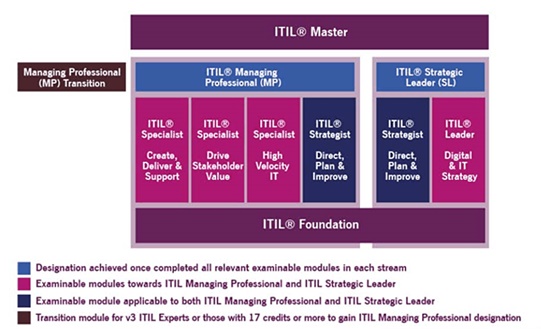
Summary
The feedback from two events demonstrated that the participants took a lot away from each of them. It was clear that the various 26 organizations in attendance had made varying levels of progress in embracing high velocity into their service management practices. Despite this it was clear that everyone recognised that change was on the horizon and aligning to a high velocity approach for service management will help to better support the demands from the business.
The changing service management landscape explored the changing business world and the increasing dependency on technology. Key to service management coping with this demand is how it adopts an integrated approach of the various practices that are available to them – ITIL4, DevOps, Agile, Lean, etc should all be considered alongside each other taking into account specific organizations requirements.
MarsLander demonstrated the concepts and ideas that are being deployed out there in the industry and the value they bring from the point of view of an improved service management capability. The workshop itself can bring value to organizations at the start of their transformation journey and/or to support on ongoing initiative.
ITIL 4 is here and fully embraces high velocity service management. MarsLander will be updated to align to ITIL 4 and should be considered for practical learning of the new world alongside or instead of traditional examination-led training. The ITIL 4 qualification scheme outlines the planned release of courses into 2019, providing a transition path for existing ITIL Experts and a streamlined scheme for those in the early stages of investing in their ITIL education.
Sysop are grateful for all the participants for their contribution throughout the day. A special thanks to GamingWorks and Jan Schilt for providing us with use and delivery of the MarsLander™ simulation.
For further information on anything covered in this whitepaper then please contact Sysop at admin@sysop.co.uk or +441706 361110.
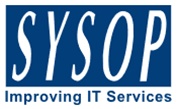
ITIL® is a registered trademark of AXELOS Limited, used under permission of AXELOS Limited. All rights reserved.© Sysop Limited 2018. This document and its contents are not to be reproduced without permission from Sysop.





